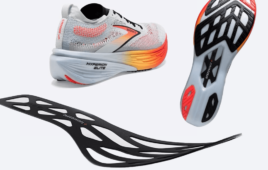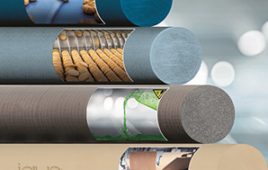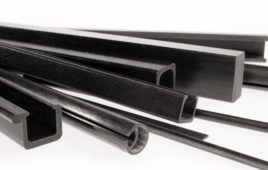Researchers have taken a step toward practical applications for “hyperbolic metamaterials,” ultra-thin crystalline films that could bring optical advances including powerful microscopes, quantum computers and high-performance solar cells.
New developments are reminiscent of advances that ushered in silicon chip technology, said Alexandra Boltasseva, a Purdue University associate professor of electrical and computer engineering.
Optical metamaterials harness clouds of electrons called surface plasmons to manipulate and control light. However, some of the plasmonic components under development rely on the use of metals such as gold and silver, which are incompatible with the complementary metal–oxide–semiconductor (CMOS) manufacturing process used to construct integrated circuits and do not transmit light efficiently.
Now researchers have shown how to create “superlattice” crystals from layers of the metal titanium nitride and aluminum scandium nitride, a dielectric, or insulator. Superlattices are crystals that can be grown continuously by adding new layers, a requirement for practical application.
“This work is a very important step in terms of fundamental contributions in materials science and optics as well as paving the way to some interesting applications,” Boltasseva said. “We believe this demonstration brings a paradigm shift to the field of metamaterials similar to developments that led to dramatic advances in silicon technology.”
Research findings are detailed in a paper appearing this week in the online Early Edition of Proceedings of the National Academy of Sciences.
Researchers created the superlattices using a method called epitaxy, “growing” the layers inside a vacuum chamber with a technique known as magnetron sputtering. It is difficult to use the technique to create structures that have sharply defined, ultra-thin and ultra-smooth layers of two different materials.
“This is one of the first reports of a metal-dielectric epitaxial superlattice,”said Purdue doctoral student Bivas Saha, co-lead author of the PNAS paper with Gururaj V. Naik, a former Purdue doctoral student and now a postdoctoral scholar at Stanford University.
The list of possible applications for metamaterials includes a “planar hyperlens” that could make optical microscopes 10 times more powerful and able to see objects as small as DNA, advanced sensors, more efficient solar collectors, and quantum computing.
“Plasmonic and metamaterial devices require good material building blocks, both plasmonic and dielectric, in order to be useful in any real-world application,” Boltasseva said. “Here, we develop both plasmonic and dielectric materials that can be grown epitaxially into ultra-thin and ultra-smooth layers with sharp interfaces.”
Metamaterials have engineered surfaces that contain features, patterns or elements, such as tiny antennas or alternating layers of nitrides that enable unprecedented control of light. Under development for about 15 years, the metamaterials owe their unusual potential to precision design on the scale of nanometers.
The PNAS paper was authored by Naik; Saha; doctoral students Jing Liu and Sammy M. Saber; Eric Stach, a researcher at Brookhaven National Laboratory; Joseph Irudayaraj, a professor in Purdue’s Department of Agricultural and Biological Engineering; Timothy D. Sands, executive vice president for academic affairs and provost and Basil S. Turner Professor of Engineering in the Schools of Materials Engineering and Electrical and Computer Engineering; Vladimir M. Shalaev, scientific director of nanophotonics at Purdue’s Birck Nanotechnology Center and a distinguished professor of electrical and computer engineering; and Boltasseva.
“This work results from a unique collaboration between nanophotonics and materials science,” Boltasseva said.
The hyperbolic metamaterial behaves as a metal when light is passing through it in one direction and like a dielectric in the perpendicular direction. This “extreme anisotropy” leads to “hyperbolic dispersion” of light and the ability to extract many more photons from devices than otherwise possible, resulting in high performance.
The layers of titanium nitride and aluminum scandium nitride used in this study are each about 5 to 20 nanometers thick. However, researchers have demonstrated that such superlattices can also be developed where the layers could be as thin as 2 nanometers, a tiny dimension only about eight atoms thick.
“People have tried for more than 50 years to combine metals and semiconductors with atomic-scale precision to build superlattices,” Saha said. “However, this is one of the first demonstrations of achieving that step. The fascinating optical properties we see here are a manifestation of extraordinary structural control that we have achieved.”
The feat is possible by choosing a metal and dielectric with compatible crystal structures, enabling the layers to grow together as a superlattice. The researchers alloyed aluminum nitride with scandium nitride, meaning the aluminum nitride is impregnated with scandium atoms to alter the material’s crystal lattice to match titanium nitride’s.
“The possibility of growing both metal and dielectric material components as a whole epitaxial system is indispensable for realizing high-performance metamaterials,” Saha said. “One of the stumbling blocks is the fact that common dielectrics such as silica, alumina and other oxides cannot be used in combination with metallic components such as metal nitrides because the deposition processes are not compatible with each other.”
Both of the materials should possess the same or compatible crystal structures.
“In general, a lattice mismatch of less than 5 percent is necessary for growing epitaxial quality films,” he said.
A U.S. patent application has been filed through the Purdue Office of Technology Commercialization.
The material has been shown to work in a broad spectrum from near-infrared to visible light, potentially promising a wide array of applications.
“That’s a novel part of this work – that we can create a superlattice metamaterial showing hyperbolic dispersion in the visible spectrum range,” Boltasseva said.
The near-infrared is essential for telecommunications and optical communications, and visible light is important for sensors, microscopes and efficient solid-state light sources.
“Most interesting is the realm of quantum information technology,” she said.
Computers based on quantum physics would have quantum bits, or “qubits,” that exist in both the on and off states simultaneously, dramatically increasing the computer’s power and memory. Quantum computers would take advantage of a phenomenon described by quantum theory called “entanglement.” Instead of only the states of one and zero used in conventional computer processing, there are many possible “entangled quantum states” in between one and zero, increasing the capacity to process information.
The research has been funded in part by the U.S. Army Research Office and the National Science Foundation.
Filed Under: Materials • advanced




